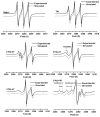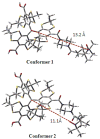Structural factors controlling the spin-spin exchange coupling: EPR spectroscopic studies of highly asymmetric trityl-nitroxide biradicals
- PMID: 23320522
- PMCID: PMC4073598
- DOI: 10.1021/ja311571v
Structural factors controlling the spin-spin exchange coupling: EPR spectroscopic studies of highly asymmetric trityl-nitroxide biradicals
Abstract
Highly asymmetric exchange-coupled biradicals, e.g., the trityl-nitroxides (TNs), possess particular magnetic properties that have opened new possibilities for their application in biophysical, physicochemical, and biological studies. In the present work, we investigated the effect of the linker length on the spin-spin coupling interaction (J) in TN biradicals using the newly synthesized biradicals CT02-GT, CT02-AT, CT02-VT, and CT02-PPT as well as the previously reported biradicals TNN14 and TN1. The results show that the magnitude of J can be easily tuned from ~4 G (conformer 1 in CT02-PPT) to >1200 G (in TNN14) by varying the linker separating the two radical moieties and changing the temperature. Computer simulations of EPR spectra were carried out to estimate J values of the TN biradicals directly. In addition to the spin-spin coupling interaction of TN biradicals, their g, hyperfine-splitting, and zero-field-splitting interactions were explored at low temperature (220 K). Our present study clearly shows that varying the spin-spin interaction as a function of linker distance and temperature provides an effective strategy for the development of new TN biradicals that can find wide applications in relevant fields.
Figures







Similar articles
-
Supramolecular host-guest interaction of trityl-nitroxide biradicals with cyclodextrins: modulation of spin-spin interaction and redox sensitivity.Org Biomol Chem. 2016 Feb 7;14(5):1694-701. doi: 10.1039/c5ob02450a. Org Biomol Chem. 2016. PMID: 26700002 Free PMC article.
-
Synthesis of 14N- and 15N-labeled trityl-nitroxide biradicals with strong spin-spin interaction and improved sensitivity to redox status and oxygen.J Org Chem. 2010 Nov 19;75(22):7796-802. doi: 10.1021/jo1016844. Epub 2010 Oct 28. J Org Chem. 2010. PMID: 21028905 Free PMC article.
-
Diastereoisomers of l-proline-linked trityl-nitroxide biradicals: synthesis and effect of chiral configurations on exchange interactions.Chem Sci. 2018 Apr 5;9(19):4381-4391. doi: 10.1039/c8sc00969d. eCollection 2018 May 21. Chem Sci. 2018. PMID: 29896379 Free PMC article.
-
Detection and characterisation of radicals using electron paramagnetic resonance (EPR) spin trapping and related methods.Methods. 2016 Oct 15;109:21-30. doi: 10.1016/j.ymeth.2016.05.013. Epub 2016 May 19. Methods. 2016. PMID: 27211009 Review.
-
Examples of high-frequency EPR studies in bioinorganic chemistry.J Biol Inorg Chem. 2003 Feb;8(3):235-47. doi: 10.1007/s00775-002-0429-0. Epub 2002 Dec 20. J Biol Inorg Chem. 2003. PMID: 12589559 Review.
Cited by
-
Dipolar pathways in multi-spin and multi-dimensional dipolar EPR spectroscopy.Phys Chem Chem Phys. 2022 Sep 28;24(37):22645-22660. doi: 10.1039/d2cp03048a. Phys Chem Chem Phys. 2022. PMID: 36106486 Free PMC article.
-
Highly bioresistant, hydrophilic and rigidly linked trityl-nitroxide biradicals for cellular high-field dynamic nuclear polarization.Chem Sci. 2022 Nov 17;13(47):14157-14164. doi: 10.1039/d2sc04668g. eCollection 2022 Dec 7. Chem Sci. 2022. PMID: 36540821 Free PMC article.
-
Efficient cross-effect dynamic nuclear polarization without depolarization in high-resolution MAS NMR.Chem Sci. 2017 Dec 1;8(12):8150-8163. doi: 10.1039/c7sc02199b. Epub 2017 Oct 2. Chem Sci. 2017. PMID: 29619170 Free PMC article.
-
Exploring Applications of Covalent Organic Frameworks: Homogeneous Reticulation of Radicals for Dynamic Nuclear Polarization.J Am Chem Soc. 2018 Jun 6;140(22):6969-6977. doi: 10.1021/jacs.8b02839. Epub 2018 May 25. J Am Chem Soc. 2018. PMID: 29799739 Free PMC article.
-
Efficient Dynamic Nuclear Polarization at 800 MHz/527 GHz with Trityl-Nitroxide Biradicals.Angew Chem Int Ed Engl. 2015 Sep 28;54(40):11770-4. doi: 10.1002/anie.201504292. Epub 2015 Aug 12. Angew Chem Int Ed Engl. 2015. PMID: 26268156 Free PMC article.
References
-
- Song CS, Hu KN, Joo CG, Swager TM, Griffin RG. J Am Chem Soc. 2006;128:11385–11390. - PubMed
-
- Zagdoun A, Casano G, Ouari O, Lapadula G, Rossini AJ, Lelli M, Baffert M, Gajan D, Veyre L, Maas WE, Rosay M, Weber RT, Thieuleux C, Coperet C, Lesage A, Tordo P, Emsley L. J Am Chem Soc. 2012;134:2284–2291. - PubMed
Publication types
MeSH terms
Substances
Grants and funding
LinkOut - more resources
Full Text Sources
Other Literature Sources
Miscellaneous

